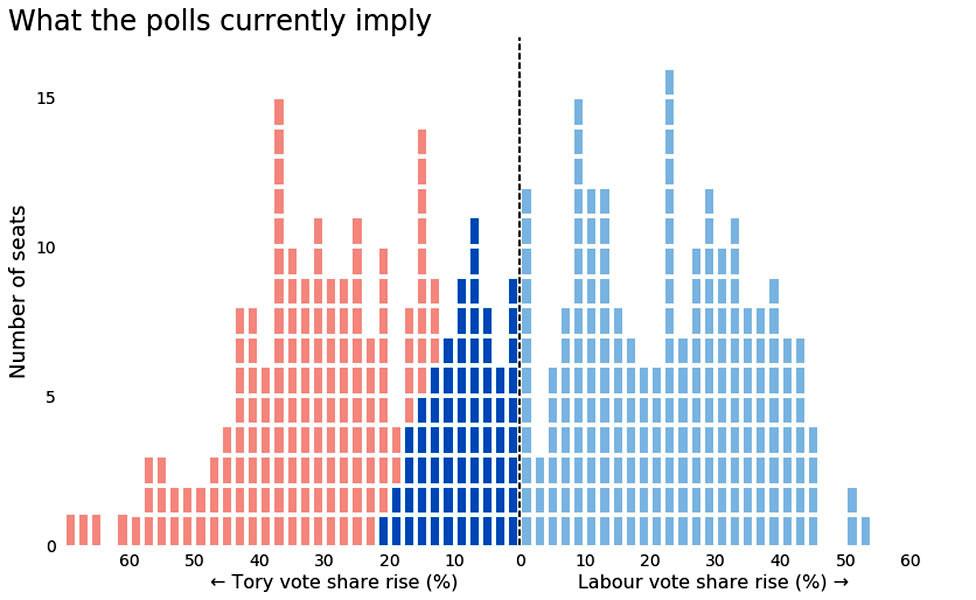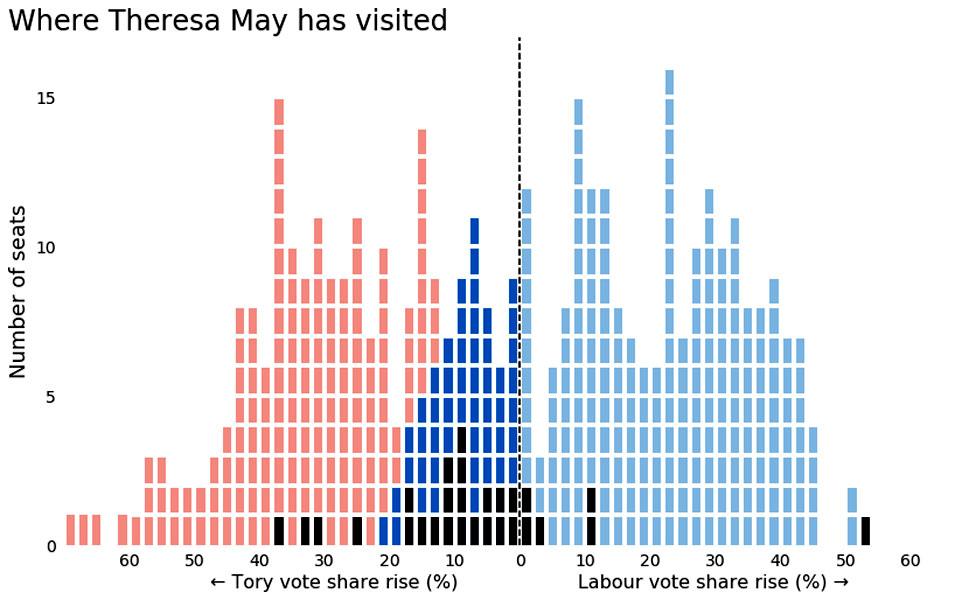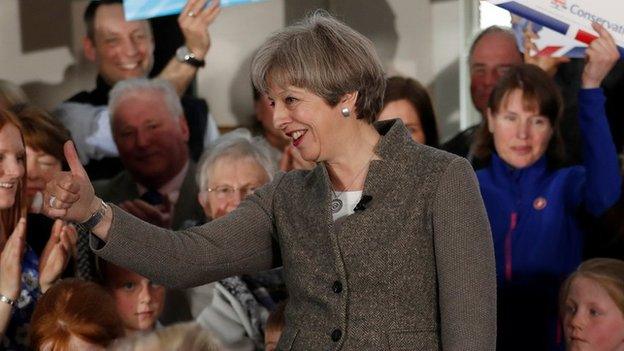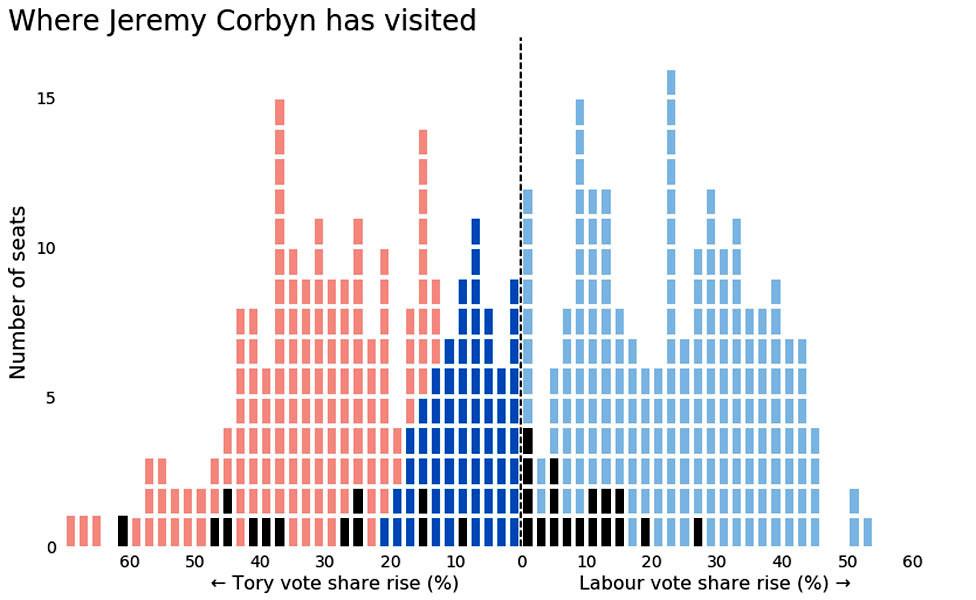General election 2017: A tale of two campaigns
- Published

One of the most striking factors about this election campaign is that Labour and the Conservative Party appear to be running two entirely unconnected election campaigns.
With colleagues in BBC News, we have been tracking where the party leaders are going. And, frankly, the Conservative game plan seems extremely straightforward.
To illustrate that, here is a chart: each block represents a Tory-facing Labour seat (in red) or a Labour-facing Tory seat (in blue). And each stack of blocks tells you how many seats each party gains if they improve their polling, in 2 percentage points increments.

So, for example, the red stack left of the centre line is nine high. If the Tories were to uniformly poll 2 percentage points higher on election day than they did in 2015 relative to Labour, they would take nine seats. Conversely, a two-point improvement for Labour relative to the Tories would yield 12 seats.
Of course, at the moment, the Conservatives are well ahead of where they were at the last general election, while Labour are doing much the same. Political scientist Dr Chris Hanretty from the University of East Anglia estimates, external the likely result is for the Conservatives to take seats, roughly as follows.

That dark blue zone is the area where, according to Dr Hanretty's maths, about 70 seats are now likely to go Conservative, having been Labour seats in 2015. Those seats - and seats like them - are the front line in this election.
The Theresa May game plan
We can overlay that graph with black blocks that show the sort of places where Theresa May has visited.

What does this mean? Well, Mrs May is spending the bulk of her time in front line seats. She made one visit to Maidenhead, her own seat, which is the block to the far right. But it is very clear where she thinks the fight is - and it is roughly where Dr Hanretty thinks it is.
There is, though, a subtler game being played. We do not talk much about the importance to campaigns of getting on local TV and radio bulletins, which have huge audiences and credibility. But parties obsess over it. More people tune into BBC One's regional news bulletins at 6:30pm than the national news at 6pm.
You could divide the country into BBC radio or TV regions to illustrate this. But here, for example, are the number of days in which Mrs May has made a visit to each ITV region or sub-region, external.
That emphasis on the West Midlands and Yorkshire is telling: 28 of the seats that Dr Hanretty currently expects to flip are in those two areas.
This way of thinking may also clarify things for some activists who were puzzled as to why Theresa May went campaigning in rural Aberdeenshire. It put her into STV North, which covers a few target seats currently held by the SNP. And note, she only has one region yet to reach.

Theresa May campaigning in Aberdeenshire
Mr Corbyn's visits, though, are harder to make sense of. Reproducing the same charts, you can see few of his visits have been into the seats that polling currently implies will change hands. On this chart, the black blocks represent his campaign trips. Of the battleground seats, Mr Corbyn has been to three.

Mr Corbyn is holding events in safe Labour seats and in Tory seats which, the polls suggest, are very unlikely to be won. But he is not doing much in the zone in between, where seats are most likely to change hands. Why?
Explaining the Labour strategy
The simplest answer is that Mr Corbyn's team simply think the polls are wrong. They think the Tory seats he's going to are going to go red - and the Tories are wasting their time fighting in seats that will stay with Labour. We will see. A less simple answer is that his campaign has chosen not to take him to the front line. Several Labour MPs in those seats have made it clear that they think his presence will not help them persuade swing voters.
This pattern has been noticed by some of his critics who wonder if this is about life after 8 June. Mr Corbyn, some Labour insiders say, is visiting safe seats where Labour activists are over-represented to bolster his place in the next Labour leadership race. Two Labour MPs suggested to me he is trying to maximise the popular Labour vote to help bolster his argument for staying on in the event of a defeat.
Broadcasting, though, is a factor to consider in all this. ITV audiences in target seats may not notice exactly where he is. Mr Corbyn has been getting into the TV regions - and it is possible he is generating better pictures, addressing big crowds, by visiting safer Labour seats.
Whatever the rationale, the only thing that's utterly clear is that Mrs May and Mr Corbyn aren't fighting this election in the same way.
Additional work by Jack Evans and Daniel Dunford